新技能英语(1)Unit2
- 格式:ppt
- 大小:32.25 MB
- 文档页数:18
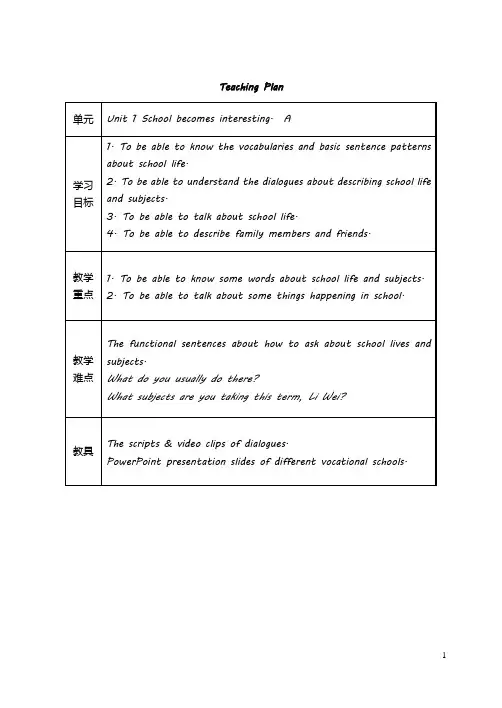
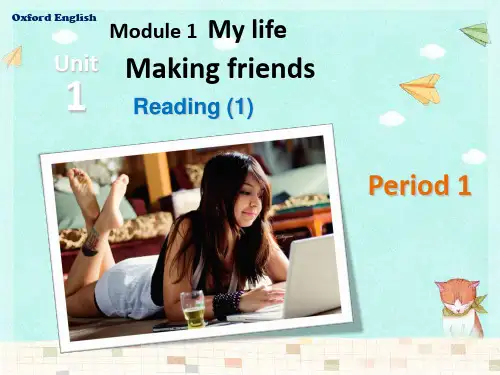

u n i t1新技能英语教学设计-CAL-FENGHAI-(2020YEAR-YICAI)_JINGBIAN新技能英语高级教程第二册Unit 1 It’s so great to be young!一、单元整体解读及分析二、分课时教学设计第1课时第2课时第3课时第4课时第5课时第6课时Reading and Vocabulary 译文:波莉是一名来自美国的十八岁的女孩,高中毕业后她有一年的间隔年。
她作为志愿者曾经在南非的野生动物保护中心工作过一年。
她回忆到:这个间隔年的经历很精彩,它让我发现了我以前未知的潜力。
这个经历让我永生难忘!间隔年是指高中毕业到上大学之间所间隔的一年。
很多年轻人利用这一年的时间去旅行,赚钱或是获得更多的工作方面的经验。
不同人对学术间断年的态度不一。
让我们来看看一些学生是如何来谈论它的。
莉萨:我很想拥有这样一个间隔年。
我相信间隔年可以帮助我找到我真的想在未来做的事情。
我热爱旅游,所以,在这空闲的一年,我会环球旅行,和不同的文化进行接触。
一年的时间足够让我去任何地方并认识整个世界。
在这一年里,我也可以做一些兼职,挣些钱去支付我旅行的费用。
安迪:好多人在高中时不知道自己想要做什么。
用间隔年这段时间去弄清楚自己未来的方向是很明智的做法。
你可以在你的简历中写上自己的现实价值,并通过在一些特定领域的工作来拓展自己珍贵的第一手的行业知识。
王晓明:如果有机会的话我想拥有一个间隔年。
我可以找一份兼职工作或当一名志愿者去挖掘我的能力。
此外,间隔年可以帮助我更好地为大学和社会做好准备。
然而,间隔年也让我有一点担心,因为,学生在这么小的年纪就独自出去工作或旅行很可能遇到危险。
此外,一些学生发现,旅行或工作一年后他们很难再次适应学术氛围。
Around the World译文:霹雳舞是街舞的一种,它是风格、肢体协调与美的结合。
霹雳舞在美国的早期发展阶段起源于嘻哈音乐。
霹雳舞最流行的动作之一就是舞者用一只手支撑自己的身体,在地上旋转并伴随复杂的踢腿动作。


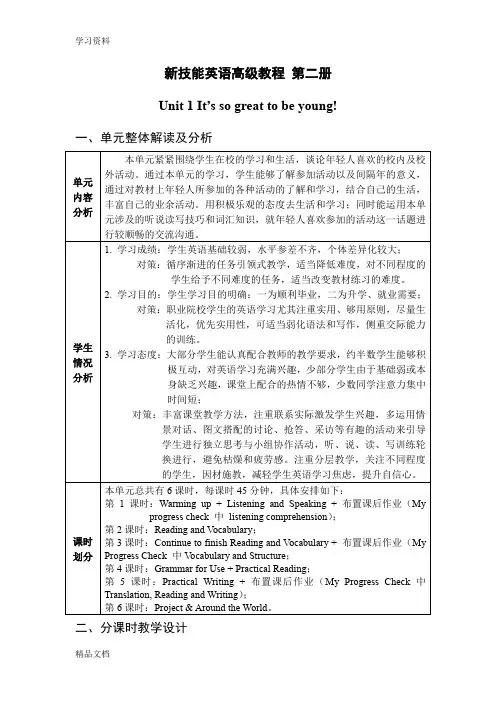
新技能英语高级教程第二册Unit 1 It’s so great to be young!一、单元整体解读及分析二、分课时教学设计第1课时第2课时第3课时第4课时第5课时第6课时Reading and Vocabulary译文:波莉是一名来自美国的十八岁的女孩,高中毕业后她有一年的间隔年。
她作为志愿者曾经在南非的野生动物保护中心工作过一年。
她回忆到:这个间隔年的经历很精彩,它让我发现了我以前未知的潜力。
这个经历让我永生难忘!间隔年是指高中毕业到上大学之间所间隔的一年。
很多年轻人利用这一年的时间去旅行,赚钱或是获得更多的工作方面的经验。
不同人对学术间断年的态度不一。
让我们来看看一些学生是如何来谈论它的。
莉萨:我很想拥有这样一个间隔年。
我相信间隔年可以帮助我找到我真的想在未来做的事情。
我热爱旅游,所以,在这空闲的一年,我会环球旅行,和不同的文化进行接触。
一年的时间足够让我去任何地方并认识整个世界。
在这一年里,我也可以做一些兼职,挣些钱去支付我旅行的费用。
安迪:好多人在高中时不知道自己想要做什么。
用间隔年这段时间去弄清楚自己未来的方向是很明智的做法。
你可以在你的简历中写上自己的现实价值,并通过在一些特定领域的工作来拓展自己珍贵的第一手的行业知识。
王晓明:如果有机会的话我想拥有一个间隔年。
我可以找一份兼职工作或当一名志愿者去挖掘我的能力。
此外,间隔年可以帮助我更好地为大学和社会做好准备。
然而,间隔年也让我有一点担心,因为,学生在这么小的年纪就独自出去工作或旅行很可能遇到危险。
此外,一些学生发现,旅行或工作一年后他们很难再次适应学术氛围。
Around the World译文:霹雳舞是街舞的一种,它是风格、肢体协调与美的结合。
霹雳舞在美国的早期发展阶段起源于嘻哈音乐。
霹雳舞最流行的动作之一就是舞者用一只手支撑自己的身体,在地上旋转并伴随复杂的踢腿动作。
跑酷来源于法语词parcours,意思是路线或道路。
跑酷的目的是跳跃攀爬任何障碍物如围墙、台阶或栅栏等。
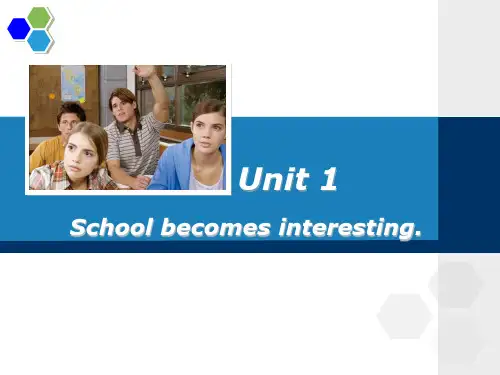
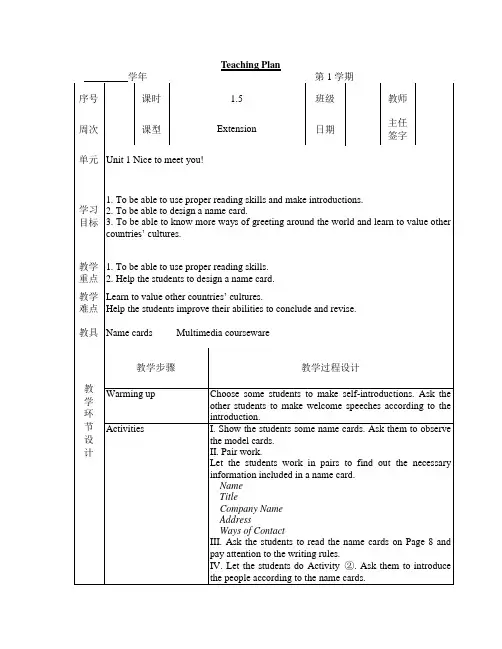
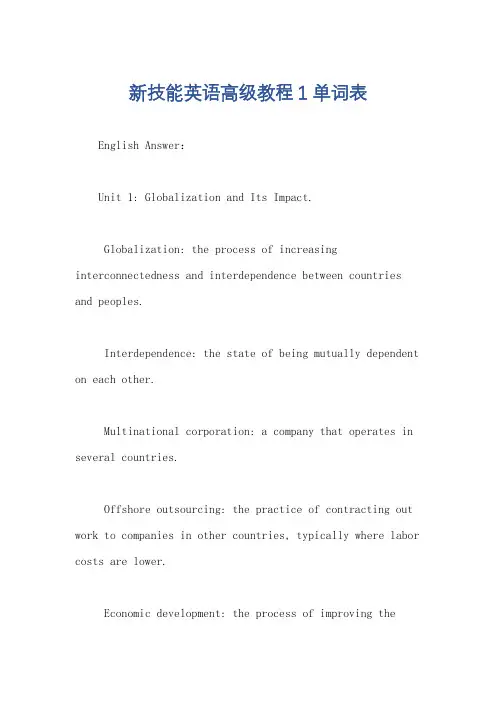
新技能英语高级教程1单词表English Answer:Unit 1: Globalization and Its Impact.Globalization: the process of increasing interconnectedness and interdependence between countries and peoples.Interdependence: the state of being mutually dependent on each other.Multinational corporation: a company that operates in several countries.Offshore outsourcing: the practice of contracting out work to companies in other countries, typically where labor costs are lower.Economic development: the process of improving theeconomic well-being of a country or region.Human development: the process of expanding human capabilities and choices.Sustainable development: development that meets the needs of the present without compromising the ability of future generations to meet their own needs.Unit 2: Technological Advancements.Artificial intelligence (AI): the ability of computers to perform tasks that normally require human intelligence.Blockchain: a distributed database that is used to maintain a continuously growing list of records, called blocks.Cloud computing: the delivery of computing services over the internet.E-commerce: the buying and selling of goods orservices over the internet.Internet of Things (IoT): the network of physical devices that are connected to the internet.Machine learning: the ability of computers to learn without being explicitly programmed.Virtual reality (VR): the use of computer technology to create a simulated environment that can be experienced by the user.Unit 3: Environmental Challenges.Climate change: the long-term alteration of temperature and typical weather patterns in a place.Deforestation: the clearing of forests.Desertification: the process by which land becomes desert.Environmental degradation: the damage or destruction of the natural environment.Extinction: the dying out of a species.Global warming: the gradual increase in the average temperature of the Earth's atmosphere.Pollution: the contamination of the natural environment with harmful substances.Unit 4: Social and Cultural Changes.Cultural diversity: the variety of cultural practices and beliefs that exist in a society.Cultural identity: the sense of belonging to a particular culture.Cultural relativism: the belief that all cultures are valid and should be respected.Globalization of culture: the spread of cultural practices and beliefs across national borders.Intercultural communication: communication between people from different cultural backgrounds.Social change: the transformation of socialinstitutions and practices over time.Social inequality: the unequal distribution of resources and opportunities in a society.Unit 5: Global Health and Well-being.Access to healthcare: the ability to obtain healthcare services when needed.Communicable diseases: diseases that can be transmitted from one person to another.Global health: the health of people around the world.Health disparities: the differences in health outcomes between different groups of people.Non-communicable diseases: diseases that are not transmitted from one person to another.Public health: the science and art of preventing disease, prolonging life, and promoting health through organized efforts.Universal health coverage: the provision of health services to all people, regardless of their ability to pay.Unit 6: International Relations.Diplomacy: the conduct of international relations through negotiation and dialogue.Foreign policy: the policy of a government towards other countries.Globalization of politics: the increasinginterconnectedness and interdependence of political systems around the world.International law: the body of law that governs relations between states.International organizations: organizations that are composed of member states and that work to promote cooperation among them.National security: the protection of a country from threats to its security.War: a state of armed conflict between two or more countries.中文回答:单元 1,全球化及其影响。


新技能英语学生用书1课后答案新智慧版1、I tell my mother not ______ me.()[单选题] *A. worry aboutB. to worry about(正确答案)C. worry withD. to worry with2、Words are windows()you can look into the past. [单选题] *A. through which(正确答案)B. through thatC. whichD. whose3、The language school started a new()to help young learners with reading and writing. [单选题] *A. course(正确答案)B. designC. eventD. progress4、6.—How can we get to the school?—________ bus. [单选题] *A.ToB.OnC.By(正确答案)D.At5、22.Will there ________ any schools in the future? [单选题] *A.isB.areC.amD.be(正确答案)6、_____from far away, the 600-meter tower is stretching into the sky. [单选题] *A. SeeB. SeeingC. To seeD. Seen(正确答案)7、—Excuse me, how long does it ______ to walk to the library? —About 15 minutes, I’m afraid.()[单选题] *A. take(正确答案)B. spendC. costD. pay8、Experts are making an investigation on the spot. They want to find a way to()the tower. [单选题] *A. Restore(正确答案)B. resumeC. recoverD. reunite9、--Do you have a _______?--Yes, I _______ at a clothes store. [单选题] *A. work; workB. work; jobC. job; jobD. job; work(正确答案)10、—What can I do to help at the old people’s home?—You ______ read stories to the old people. ()[单选题] *A. could(正确答案)B. mustC. shouldD. would11、Three ______ died of water pollution last winter. [单选题] *A. hundreds of villagersB. hundred villagers(正确答案)C. hundreds villagersD. hundred of villagers12、Was()that I saw last night at the concert? [单选题] *A. it you(正确答案)B. not youC. youD. that yourself13、30.It is known that ipad is _________ for the old to use. [单选题] * A.enough easyB.easy enough (正确答案)C.enough easilyD.easily enough14、I always make my daughter ______ her own room.()[单选题] *A. to cleanB. cleaningC. cleansD. clean(正确答案)15、We were caught in a traffic jam. By the time we arrived at the airport the plane _____. [单选题] *A. will take offB. would take offC. has taken offD. had taken off(正确答案)16、( ) Do you have any difficulty _____ these flowers?I’d like to help you if you need.[单选题] *A in planting(正确答案)B for plantingC with plantingD to plant17、—______?—He can do kung fu.()[单选题] *A. What does Eric likeB. Can Eric do kung fuC. What can Eric do(正确答案)D. Does Eric like kung fu18、65.There is a big sale on in the shop! Every-thing is ________ price. [单选题] * A.bigB.fullC.zeroD.half(正确答案)19、The book is very _______. I’ve read it twice. [单选题] *A. interestB. interestedC. interesting(正确答案)D. interests20、( ) --------Please take my seat here.-------- __________________________. [单选题]*A. That is nice of you(正确答案)B. I think it is my seatC. No, you sit hereD. I don’t think it’s a good seat.21、He often comes to work early and he is _______ late for work. [单选题] *A. usuallyB. never(正确答案)C. oftenD. sometimes22、—______ is the concert ticket?—It’s only 160 yuan.()[单选题] *A. How manyB How much(正确答案)C. How oftenD. How long23、( ) My mother told me _____ in bed. [单选题] *A. not readB. not readingC. don’t readD. not to read(正确答案)24、If it _______ tomorrow, I won’t go there. [单选题] *A. rains(正确答案)B. is rainingC. will rainD. would rain25、“I think you are wonderful,”she said, “You are so patient with your little George.”[单选题] *A. 耐心(正确答案)B. 细心C. 关心D. 偏心26、--I can’t watch TV after school.--I can’t, _______. [单选题] *A. alsoB. tooC. either(正确答案)D. so27、There are many_____desks in the room. [单选题] *rge old brown(正确答案)B.old large brownrge brown oldD.brown old large28、You cannot see the doctor _____ you have made an appointment with him. [单选题] *A. exceptB.evenC. howeverD.unless(正确答案)29、57.Next week will be Lisa's birthday. I will send her a birthday present ________ post. [单选题] *A.withB.forC.by(正确答案)D.in30、Patrick bought her two handbags as gifts,but _____ of them was her style. [单选题] *A. eitherB. noneC. neither(正确答案)D. all。
Unit 3Score: Time: 40’Part I. Listening ComprehensionDirections: This part is to test your listening ability. It consists of 3 sections. Section A (8 points)Directions: This section is to test your ability to give proper responses. There are 4 recorded questions in it. After each question, there is a pause. The questions will be spoken two times. When you hear a question, you should decide on the correct answer from the 4 choices marked A, B, C and D.1. A. I’m sorry to hear that. B. O K.C. Make a spending plan. That will help.D. Why?2. A. You should have a budget. B. See you later.C. How stupid!D. You’re wrong.3. A. That’s great. B. Sorry to hear that.C. OK. Thank you.D. How did you make it?4. A. That’s all right. B. Excuse me. C. I’m sorry. D. Sure.Section B (4 points)Directions: This section is to test your ability to understand short dialogues. There are 2 recorded dialogues in it. After each dialogue, there is one recorded question. Both the dialogues and questions will be spoken two times. When you hear a question, you should decide on the correct answer from the 4 choices marked A, B, C and D.5. A. He pays all his bills. B. He checks his wallet.C. He makes ends meet.D. He writes down the monthly budget.6. A. He is going to give the woman some advice. B. He never overspends.C. He is learning about budgeting.D. He doesn’t know the woman much.Section C (8 points)Directions: In this section you will hear a short passage. Listen to the passage and fill in each blank IN NOT MORE THAN THREE WORDS. The passage will be read three times.Saving money is much (7) ________ than done. It is more than (8)________. Actually, it can be a (9) ________ task. To save money, you may have to ask yourself: How much money can I save monthly? Where should I keep the money, and how can you make sure that I don’t overspend again? Follow along to learn how to set realistic goals, keep your spending (10) ________, and get the most for your money.Part II. Vocabulary & StructureDirections: This part is to test your ability to use words and phrases correctly to construct meaningful and grammatically correct sentences. It consists of 2 sections. Section A (10 points)Directions: There are 5 incomplete statements here. You are required to complete each statement by choosing the appropriate answer from the 4 choices marked A, B,C and D.11. Do you feel that you have no or very little control your life?A. overB. withC. toD. at12. You may go if you keep overspending.A. brokeB. breakC. brokenD. breaking13. She finds it impossible to stick a diet.A. forB. toC. atD. by14. me have a try.A. Letting.B. Let’sC. LetD. Lets15. Come here, ?A. will youB. do youC. don’t youD. shall youSection B (15 points)Directions: There are 5 incomplete statements here. You should fill in each blank with the proper form of the words in the brackets.16. I don’t feel ready to take on new (responsible).17. I can’t afford it, because it’s too (inexpensive).18. The price of the shoes is (reason).19. The players all have (confident) in their manager.20. She regrets (come) to see the movie.Part III. Reading ComprehensionDirections: This part is to test your reading ability. You will find 2 tasks for you to fulfill. You should read the reading materials carefully and do the tasks as you are instructed.Task 1 (10 points)Directions: After reading the following passage, you will find 5 questions or unfinished statements. For each question or statement there are 4 choices marked A, B, C and D. You should make the correct choice.Want to start budgeting? Set up your own budget first.Follow the steps below to set up your own budget:Make a list of your values. Write down what matters to you and then put your values in order.Set your goals. Write down your goals. Think about what you want to accomplish financially in the next three months, the next year, and the next three years.Determine your income. Figure your available income. Do not include overtime pay, because you shouldn’t rely on that as regular income.Determine your expenses. Review your checkbook, credit card statements, store receipts, and so on. Find out where is your money really goes? “Fixed expenses,”such as a rent, auto, or student loan payments, are easy to determine. “Flexible expenses,”such as food, clothing, and entertainment, vary from month to month. Don’t forget about money spent on taxes or insurance, which is billed quarterly, semi-annually, or yearly.Create your budget.Think of your budget as a “spending plan”, a way to be aware of how much money you have, where it needs to go, and how much, if any, is left over. Your budget should meet your "needs" fi rst, then the “wants” that you can afford. Your expenses should be less than or equal to your total income. If your income is not enough to cover your expenses, adjust your budget by deciding whichexpenses can be reduced.Then how to stick to your budget?Pay yourself first! Saving is a very important part of protecting yourself financially. Save as much as you can every month. Even a small amount can make a big difference if you keep it up. A great goal is to establish an emergency savings fund large enough to cover three to six months of your living expenses. After you have an emergency fund, your savings can go toward meeting your goals.Check back periodically. Be sure to review your budget regularly. Does the plan still meet your needs and help you achieve your goals? If not, make some adjustments or create a new budget that better meets your needs.21. Which is the best title for this passage?A. What is BudgetingB. Why BudgetingC. Establish Your Own BudgetD. How to Stick to a Budget22. Which of the following statements is true?A. Your available income includes your salary.B. Your available income includes the money you borrow from others.C. Your available income includes overtime pay.D. Your available income includes the money you get by selling your private car.23. What do “fixed expenses” include?A. Food.B. Clothing.C. Entertainment.D. Rent.24. Which of the following statements is true?A. Your budget should meet your "wants" first.B. Your expenses should be less than or equal to your total income.C. You can use your credit card if your income is not enough to cover your expenses.D. You can use your emergency savings fund if your income is not enough to cover your expenses.25. An emergency savings fund .A. shall cover 3 to 6 years of your living expenseB. is less important than your needs.C. shall meet your wants.D. is important for you to protect yourself financially.Task 2 (10 points)Directions: The following is a passage. After reading it, you are required to answer the following questions.This is an interesting place. You come here to exchange things, you come here to save money, and you come here to give your waste things a home. What is it? Not the supermarket, not the place that deals with rubbish of course, but a place on our campus. Yes, it is the flea market. I have already sold my books and bags that I no longer need there, and have bought a lovely bottle there at a good price.Before showing you the four benefits of doing this according to my experience, I have to tell you that you should keep an open mind when you go there. You may not come away with the things that were on your list, but that's the beauty of the hunt: you never know what you'll find. If you didn't find a particular item this week, don't give up, since you'll have chance to find it next time.The following are the four reasons.Firstly, it saves money. By selling the things you no longer need, you can help those students who have not got their own income. With the similar function and a much lower price, the financial problems that troubled many poor students can be solved more easily. What’s more, experts estimated that if all textbooks in universities can be used once again, we can save about 100 million yuan which can help you to travel to moon for one time.Secondly, it helps develop a good habit. Selling waste things in a flea market can help the sellers to cultivate a good habit of making full use of their belongings. Thus you will think twice before buying a new product next time.Thirdly, it fosters an intelligence to engage in business. You can learn to communicate with others and promote sale of your products to others at a proper price by doing this. Your practical ability can also improve a lot.Last but not least, it is environmental-friendly. According to the latest report, if a small-size city reuses the textbooks for one time, they can save 1.5 million yuan in only a semester’s time.Anyway, a flea market is an interesting place to visit if you want to buy something or if you want to buy nothing. Don't be surprised if you find the very thing you have been looking for or come back home with your hands empty.Hope the fact I have presented to you will help you to make a wise choice next time when dealing with your waste things. Remember: many a little makes a fickle.26. What did the author sell in the flea market?27. What can help a seller develop a good habit of making full use of his belongings according to the article?28. How much can we save if all textbooks in universities can be used once again?29. How will selling waste things help you foster an intelligence to engage in business.30. How much money can be saved if a small-size city reuses the textbooks for one time?Part IV. Translation (15 points)Directions: This part is to test your ability to translate English into Chinese. Each of the two sentences is followed by four choices of suggested translation marked A, B and C. Make the best choice. For the paragraph numbered 33, write your translation in the corresponding space.31. What’s more, keeping up with the Joneses may get you broke.A. 另外,和琼斯家比会让你身无分文。
新技能英语学生用书2unit1答案1、Many of my classmates are working _______volunteers. [单选题] *A. as(正确答案)B. toC. atD. like2、The red jacket is _______ than the green one. [单选题] *A. cheapB. cheapestC. cheaper(正确答案)D. more cheap3、1——May I help you? You seem to be having some problems.——_______ , thanks. Ithink I can manage. [单选题] *A. All rightB. No problemC. It’s all right(正确答案)D. There’s no way4、Don't tell me the answer, I'll work out the problem _____. [单选题] *A .by meB. myself(正确答案)C. meD. mine5、I paint a lot of pictures. [单选题] *A. 评论B. 注意C. 悬挂D. 画(正确答案)6、I used to take ____ long way to take the bus that went by ____ tunnel under the water. [单选题] *A. a, aB. a. theC. a, /(正确答案)D. the, a7、The teacher asked him to practice playing the piano _______. [单选题] *A. often as possibleB. as often possibleC. as possible oftenD. as often as possible(正确答案)8、The firm attributed the accident to()fog, and no casualties have been reported until now. [单选题] *A. minimumB. scarceC. dense(正确答案)D. seldom9、Before you quit your job, ()how your family will feel about your decision. [单选题] *A. consider(正确答案)B. consideringC. to considerD. considered10、57.Next week will be Lisa's birthday. I will send her a birthday present ________ post. [单选题] *A.withB.forC.by(正确答案)D.in11、Helen is new here, so we know _______ about her. [单选题] *A. somethingB. anythingC. everythingD. nothing(正确答案)12、If you get _______, you can have some bread on the table. [单选题] *A. happyB. hungry(正确答案)C. worriedD. sad13、The language school started a new()to help young learners with reading and writing. [单选题] *A. course(正确答案)B. designC. eventD. progress14、She was seen _____ that theatre just now. [单选题] *A. enteredB. enterC. to enter(正确答案)D. to be entering15、All he _______ was a coat. [单选题] *A. had on(正确答案)B. had toC. had a restD. had a good time16、Mary wanted to travel around the world all by herself, but her parents did not _______ her to do so. [单选题] *A. forbidB. allowC. follow(正确答案)D. ask17、1.________my father ________ my mother is able to drive a car. So they are going to buyone. [单选题] *A.Neither; norB.Both; andC.Either; orD.Not only; but also(正确答案)18、The manager gave one of the salesgirls an accusing look for her()attitude towards customers. [单选题] *A. impartialB. mildC. hostile(正确答案)D. opposing19、I have seldom seen my father()pleased with my progress as he is now. [单选题] *A. so(正确答案)B. veryC. tooD. rather20、12.That is a good way ________ him ________ English. [单选题] *A.to help;forB.helps;withC.to help;with(正确答案)D.helping;in21、13.—Will you come to my party?—I am not ________ . [单选题] *A.mindB.sure(正确答案)C.happyD.Sorry22、He doesn’t smoke and hates women _______. [单选题] *A. smokesB. smokeC. smokedD. smoking(正确答案)23、I’m sorry there are ______ apples in the fridge. You must go and buy some right now.()[单选题] *A. a littleB. littleC. a fewD. few(正确答案)24、A small village cuts across the river. [单选题] *A. 切B. 穿过(正确答案)C. 划船D. 踢25、The little girl held _____ in her hand. [单选题] *A. five breadsB. five piece of breadsC. five piece of breadD. five pieces of bread(正确答案)26、42.—________ meat do you want?—Half a kilo. [单选题] * A.How much(正确答案)B.How manyC.WhatD.Which27、_______ songs is my favorite. [单选题] *A. To Singing EnglishB. Singing English(正确答案)C. Singings EnglishD. Sing English28、How _______ Grace grows! She’s almost as tall as her mother now. [单选题] *A. cuteB. strongC. fast(正确答案)D. clever29、13.________ it rains heavily outside, Lily wants to meet her children at once. [单选题]*A.IfB.Although (正确答案)C.WhenD.Because.30、You should _______ fighting with your parents although you may have different ideas from time to time. [单选题] *A. suggestB. enjoyC. avoid(正确答案)D. practice。
新技能英语学生用书2答案第一单元1、This is _________ my father has taught me—to always face difficulties and hope for the best. [单选题] *A. howB. whichC. that(正确答案)D. what2、——Have you()your friend Bill recently? ———No, he doesnt often write to me. [单选题] *A. heard aboutB. heard ofC. heard from (正确答案)D. received from3、Many people believe that _________one has, _______ one is, but actually it is not true. [单选题] *A. the more money ; the happier(正确答案)B. the more money ; the more happyC. the less money ; the happierD. the less money ; the more happy4、—Why do you look so ______?—Our team won the basketball match!()[单选题] *A. angryB. excited(正确答案)C. nervousD. unfair5、The man lost his camera and he ______ it now.()[单选题] *A. foundB. is findingC. is looking forD. looks for(正确答案)6、Online shopping _______ very popular now. [单选题] *A. is(正确答案)B. areC. wasD. were7、The children ______ visiting the museum. [单选题] *A. look overB. look forward to(正确答案)C. look forD. look after8、9.—Will there be more cars in the future?—________. [单选题] * A.See youB.Well, I'm not sure(正确答案)C.You're welcomeD.Thank you9、Do not _______ me to help you unless you work harder. [单选题] *A. expect(正确答案)B. hopeC. dependD. think10、25.—I ______ Beijing for a holiday.—________. [单选题] * A.will go;GoodbyeB.will go;Have a good time(正确答案)C.will go to;Have a good timeD.am going to;Have a fun11、Before you quit your job, ()how your family will feel about your decision. [单选题] *A. consider(正确答案)B. consideringC. to considerD. considered12、Can you _______ this form? [单选题] *A. fillB. fill in(正确答案)C. fill toD. fill with13、I_____you that I had made the right decision. [单选题] *A.ensuredB.insuredC.assured(正确答案)D.for sure14、This message is _______. We are all _______ at it. [单选题] *A. surprising; surprisingB. surprised; surprisedC. surprising; surprised(正确答案)D. surprised; surprising15、_______ travelers come to visit our city every year. [单选题] *A. Hundred ofB. Hundreds of(正确答案)C. Five HundredsD. Five hundred?of16、_______ win the competition, he practiced a lot. [单选题] *A. BecauseB. In order to(正确答案)C. Thanks toD. In addition to17、—Can you play the violin at the art festival?—No, I ______. But I am good at playing the drums.()[单选题] *A. canB. can’t(正确答案)C. doD. don’t18、I arrived _____ the city _____ 9:00 am _______ April [单选题] *A. at, in, atB. to, on, atC. in, or, atD. in, at, on(正确答案)19、He always did well at school _____ having to do part-time jobs every now and then. [单选题] *A despite ofB. in spite of(正确答案)C. regardless ofD in case of20、36.This kind of bread is terrible. I don't want to eat it ______. [单选题] *A.any more(正确答案)B.some moreC.no longerD.some longer21、The flowers _______ sweet. [单选题] *A. tasteB. smell(正确答案)C. soundD. feel22、--The last bus has left. What should we do?--Let’s take a taxi. We have no other _______ now. [单选题] *A. choice(正确答案)B. reasonC. habitD. decision23、Jane and Tom _______ my friends. [单选题] *A. amB. isC. are(正确答案)D. was24、A good teacher is able to_____a complicated idea in very simple terms. [单选题] *A.put across(正确答案)B.break upC.work outD.bring out25、He _______ walks to school, because he lives near school. [单选题] *A. sometimes(正确答案)B. neverC. doesn’tD. don’t26、( ) No matter _____ hard it may be, I will carry it out. [单选题] *A whatB whateverC how(正确答案)D however27、_____ is not known yet. [单选题] *A. Although he is serious about itB. No matter how we will do the taskC. Whether we will go outing or not(正确答案)D. Unless they come to see us28、70.Would you like ________,sir? [单选题] *A.something else(正确答案)B.nothing elseC.else somethingD.else anything29、These apples smell _____ and taste ______. [单选题] *A. well; wellB. good; good(正确答案)C. well; goodD. good; well30、I walked too much yesterday and ()are still aching now. [单选题] *A. my leg's musclesB. my leg muscles(正确答案)C. my muscles' of legD. my legs' muscles。